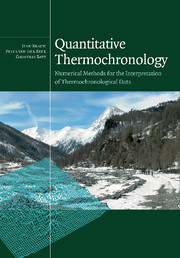Book contents
- Frontmatter
- Contents
- Preface
- 1 Introduction
- 2 Basics of thermochronology: from t–T paths to ages
- 3 Thermochronological systems
- 4 The general heat-transport equation
- 5 Thermal effects of exhumation
- 6 Steady-state two-dimensional heat transport
- 7 General transient solution – the three-dimensional problem
- 8 Inverse methods
- 9 Detrital thermochronology
- 10 Lateral advection of material
- 11 Isostatic response to denudation
- 12 The evolution of passive-margin escarpments
- 13 Thermochronology in active tectonic settings
- Appendix 1 Forward models of fission-track annealing
- Appendix 2 Fortran routines provided with this textbook
- Appendix 3 One-dimensional conductive equilibrium with heat production
- Appendix 4 One-dimensional conductive equilibrium with anomalous conductivity
- Appendix 5 One-dimensional transient conductive heat transport
- Appendix 6 Volume integrals in spherical coordinates
- Appendix 7 The complementary error function
- Appendix 8 Pecube user guide
- Appendix 9 Tutorial solutions
- References
- Index
12 - The evolution of passive-margin escarpments
Published online by Cambridge University Press: 15 December 2009
- Frontmatter
- Contents
- Preface
- 1 Introduction
- 2 Basics of thermochronology: from t–T paths to ages
- 3 Thermochronological systems
- 4 The general heat-transport equation
- 5 Thermal effects of exhumation
- 6 Steady-state two-dimensional heat transport
- 7 General transient solution – the three-dimensional problem
- 8 Inverse methods
- 9 Detrital thermochronology
- 10 Lateral advection of material
- 11 Isostatic response to denudation
- 12 The evolution of passive-margin escarpments
- 13 Thermochronology in active tectonic settings
- Appendix 1 Forward models of fission-track annealing
- Appendix 2 Fortran routines provided with this textbook
- Appendix 3 One-dimensional conductive equilibrium with heat production
- Appendix 4 One-dimensional conductive equilibrium with anomalous conductivity
- Appendix 5 One-dimensional transient conductive heat transport
- Appendix 6 Volume integrals in spherical coordinates
- Appendix 7 The complementary error function
- Appendix 8 Pecube user guide
- Appendix 9 Tutorial solutions
- References
- Index
Summary
In this chapter, we will apply several techniques described in the earlier sections to derive constraints on the evolution of continental passive-margin escarpments from low-temperature thermochronological datasets. In doing so, we will show how a three-dimensional finite-element solver of the heat-transport equation (Pecube) can be coupled to the predictions of a landscape-evolution model (Cascade) to demonstrate the sensitivity of thermochronological data to various geomorphic scenarios. We use an inverse method to demonstrate what can and, potentially most importantly, what cannot be constrained from a given thermochronological dataset. We will also show how numerical modelling can be used to devise efficient and meaningful data-collection strategies.
Introduction
Great escarpments along high-elevation rifted continental margins form some of the most prominent morphological features on Earth (Figure 12.1). Since the early 1990s, the geoscience community has re-examined these features through an array of quantitative processes, leading to an increasing appreciation of the contribution of escarpment evolution to the dynamics of rifted margins (e.g., Beaumont et al., 1999; Gilchrist and Summerfield, 1990, 1994; van der Beek et al., 1995). At the same time, the geomorphological community has shown a renewed interest in large-scale, long-term landscape development of rifted margins and other intra-plate settings (e.g., Summerfield, 2000). This work is driven by an array of fundamental questions surrounding the formation and development of high-elevation rifted margins.
- Type
- Chapter
- Information
- Quantitative ThermochronologyNumerical Methods for the Interpretation of Thermochronological Data, pp. 177 - 191Publisher: Cambridge University PressPrint publication year: 2006



